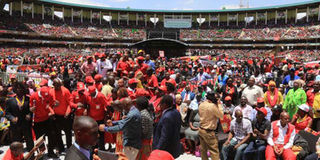Why battle of crowds between Jubilee and Cord matters

Part of the crowd at Safaricom Stadium Kasarani in Nairobi during the launch of Jubilee Party on September 10, 2016. PHOTO | JEFF ANGOTE | NATION MEDIA GROUP
What you need to know:
Today we are not so much interested in who won the fight as in why crowd sizes in politics – especially elections – are becoming increasingly important almost everywhere in the world.
In the US in this year’s election, the Republican party candidate, that strange man Donald Trump, has made the size of his crowds a big issue, bragging about and tweeting photos of them every other day.
In the past few days, we have seen a big battle of the crowds between Kenya’s ruling Jubilee and the opposition Cord at various events.
Today we are not so much interested in who won the fight as in why crowd sizes in politics – especially elections – are becoming increasingly important almost everywhere in the world.
In the US in this year’s election, the Republican party candidate, that strange man Donald Trump, has made the size of his crowds a big issue, bragging about and tweeting photos of them every other day.
The world truly is one – the US election this year is "heartwarmingly" African in every way. They are truly our people, those Americans.
So why are crowds at rallies so important? After all, we know that crowds do not win elections.
In Uganda in February, crowd size was a big issue in the election clash between President Yoweri Museveni and his long-term rival, Kizza Besigye.
Things got so thick, the Museveni campaign deployed drones to photograph his crowds with fisheye lenses to create a bigger illusion of size. When a TV station refused to use the video, it got a rap around its ears.
In the end, Besigye won the battle of the crowds but lost the count. The outcome, some claim, was determined by the size of the fingers of those who counted the votes.
IN THING
That said, crowd size is the in thing. Last year the Tanzanians got very excited when the opposition Chadema candidate, Edward Lowassa, started off with a massive rally. In the end, like in Uganda, the ruling CCM and John Magufuli won by a small margin.
In Tanzania too, we had accusations that despite the opposition crowds, when everyone had gone home, it was those who counted the votes that determined the winner.
Something is going on here, though. With shortened attention spans, and ever-growing social media, candidates no longer have audiences’ attention all day.
The most effective campaign messages are tweet-and-Instagram size. A pithy 140 characters, and a catchy photograph. When it comes to rallies, unless a fight breaks out, the best visual is the crowd size.
Those are the ones that catch the attention of netizens, then they will retweet, make memes, and give them wings.
The photographs of a candidate planting trees or handing over boreholes are too boring these days. Those are for when he or she has won and become president, and they are trying to show that they are doing great things for ordinary people.
Second, a candidate who is planning to steal votes desperately needs large crowds. You cannot be pulling only 100 people at your rallies and convince anyone, even your favourite aunt, that you miraculously went on to turn the tables and emerge victorious.
Your crowd size needs to be at a level that validates the number of votes the electoral commission allocates you.
ALSO TRUE
The reverse is also true. If you are in the opposition and suspect that the incumbent is planning to fiddle the vote, and you have intentions of challenging the theft in court, you better have big crowds.
There will be many sympathetic ears when you argue that not all crowds stayed home or, as happens in countries such as Congo (Brazzaville) or Equatorial Guinea, they all crossed over on the last day and voted for the Big Man.
Besides, it turns out that evolutionary science also has a good explanation for why candidates must focus on crowd size.
The other day I listened to a programme on BBC where a wise man was talking about it. He said that we follow crazes because it was the way our primordial societies survived.
Those days, of course, you could not order pizza to be brought to the house and the water and electricity did not find you at home. We were foraging and had not learnt to farm.
And if you slept too deeply, a wild animal would creep into the cave and pull you away for its late dinner. It was nearly impossible to survive alone.
And we were nomadic. When it became cold, there was no heating or sweaters. You moved to a warm place. Therefore, the good man said, we developed a deep fear of “being left behind by the tribe”.
Today, if there is a rally in your small town, it is a safe bet that most people will be drawn to the bigger one. These days they call it Fomo (fear of missing out).
Charles Onyango-Obbo is publisher, Africapedia.com and Roguechiefs.com.
Twitter: @cobbo3





